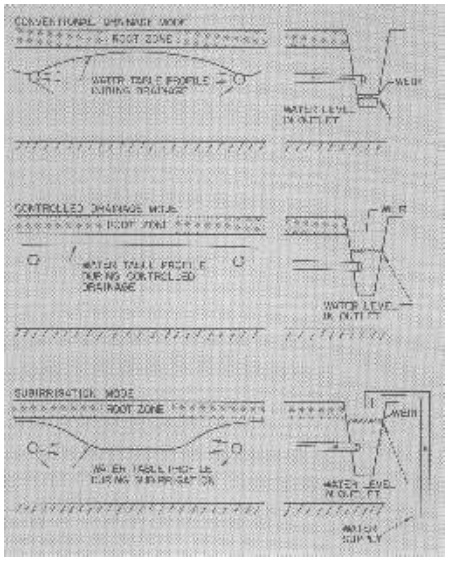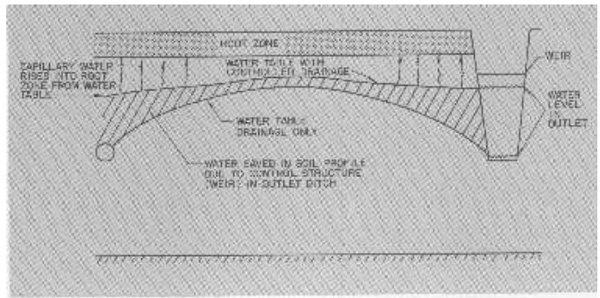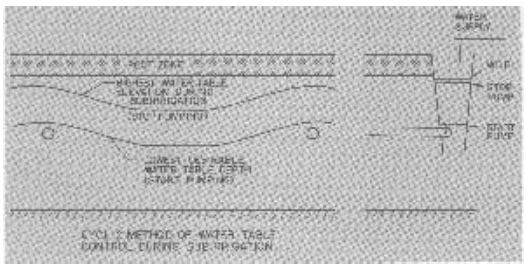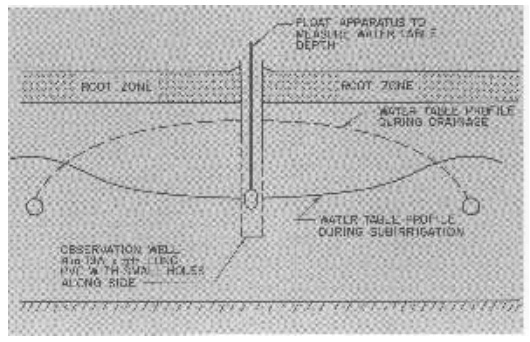Introduction
Dual-purpose drainage/subirrigation systems are now being used on poorly drained soils to reduce water-related stress on crops. The mechanics of this dual-purpose system is discussed in Agricultural Water Management for Coastal Plain Soils, AG-355. During wet periods this system operates as a drainage system (Figure 1). Here, excess water is removed from the field through a system of underground drain tubes which outlet to a main drain tube or open ditch. When a structure (such as a flashboard riser) is used in the outlet ditch to regulate the drainage rate, the system may function in either the controlled drainage or subirrigation mode. Usually a weir is placed in the control structure so that the water level in the drainage outlet has to rise higher than the weir crest before the water will flow out of the field.
The process called controlled drainage occurs when the structure is used to conserve water by reducing drainage outflows and when no additional water is pumped in. During dry periods, water may be pumped into the control outlet where it moves back through the drainage network, thus raising the water level in the field. In this mode the system is being used for subirrigation.
The dual-purpose system will normally fluctuate between the drainage, controlled drainage and subirrigation modes several times during one cropping season. Because the role of the system often changes, intensive monitoring and management of the system is necessary for effective operation.
Design Considerations
The best crop response for a drainage/subirrigation system will be realized with a system that is specifically designed to serve both purposes. Systems whose designs focus on drainage are, in general, not adequate to function in both modes. The physical limitations of the system can, however, be overcome somewhat. One way would be to increase system management. Another way to overcome some limitations would be to increase the drainage intensity of the system by installing additional tile lines between existing lines. This additional drainage capacity is needed when the water table rises, a condition which decreases the drainage capacity of any subsurface system. Land shaping to improve surface drainage may also be needed, especially on an existing system with limited drainage capacity.
If a new system is to be installed for both drainage and subirrigation, the system's size and layout must satisfy the water management needs of the specific site. Many factors influence this size and layout. For example, crop rooting depth and tolerance to water stress are important considerations. Several soil properties such as water-holding capacity, hydraulic conductivity, and location of layers within the profile should also be measured for each site. Furthermore, rainfall distribution within the geographic region under consideration will influence the design and operation of the system. Finally, farm operators should carefully evaluate the time available to "look after" the system. To reduce the initial cost, design the system for an intensive level of management. However, intensive management may not be realistic since the subirrigation system will often compete for time with other vital farm operations.
The final design of the drainage/subirrigation system should be evaluated using the water management simulation model, DRAINMOD. For initial planning purposes, subirrigation/drainage requires about 65 percent of the spacing normally needed for drainage alone. Drain tubing depth should be about 3 to 4 feet which is somewhat shallower than the depth for conventional drainage. Subirrigation offers little advantage to placing the tubing deeper unless the lower layer is more permeable than the overlying layers. The control structure should be sized and managed so that the ditch or waterway can carry its full capacity during high flow periods.
System Operation
In eastern North Carolina, removing excess water from the field is the system's most important role. Thus, in areas where droughts are temporary, the system functions mainly as a drainage system. During the traditionally wet winter and early spring period, the water-level control structure should be set below the level of the tile outlet to provide maximum drainage capacity. This water level should be maintained until after the crop has been planted and most of the trafficable operations have been completed. To maintain water quality in receiving streams, it may be desirable to operate in the controlled drainage mode during most of the winter in order to reduce nitrate outflows on some sites.
Once the system is operational, the most important management decisions include:
- when to raise/lower the control structure;
- at what height to maintain the weir in the control structure; and
- when to add water to the system.
These decisions not only may differ for every site, they may also vary with the crop. Depending on soil type, root depth, drain depth and control structure setting, from 1 to 4 inches of plant available water can be held in the profile that would otherwise drain (Figure 2). (Plant available water is any water retained in the soil that plants can use.) This amount represents from 3 days to 2 weeks of water storage that would not need to be supplied by pumping. How important this water is to the crop depends on the capabilities and limitations of the system. The following situations based on system capabilities should be considered as a guide for the initial decisions.
When to Raise/Lower the Water-Level Control Structure
Controlled drainage—Conserving water by controlled drainage is most critical on systems where supplemental water is not available. If dry conditions are anticipated, it would be desirable to raise the weir soon after planting to conserve as much water as possible. On the other hand, the system should be operated so that prolonged saturation of the root zone does not occur, especially when the crop is young. In North Carolina, late April and early May are sometimes "rainy periods." Therefore, on systems which do not have adequate drainage capacity, water table management too early in the season may result in excess water stress when the crop is young.
Raising the water table too soon or controlling the water table at a shallow depth below the soil surface will also discourage deep root growth, an effect which could make the crop more susceptible to drought later (Figure 3). Holding the water table too high will also encourage denitrification which could result in a nitrogen deficiency later in the season. Thus, the long-term average production benefit of controlled drainage greatly depends on the system's drainage capacity in addition to the severity of the drought stress.
Consider, for example, a conventional, predominately surface drainage system with inadequate drainage capacity during wet periods. In a very dry season, little benefit would be realized from controlled drainage (as compared to drainage alone) on a crop such as corn since very few soils can store enough water to grow a crop without rainfall for 6 to 8 weeks. However, a controlled drainage system can store enough water to reduce drought stress for short periods. For this reason, the greatest benefit will be realized in years which have frequent small rains (often less than 1 inch) with only short droughts. But in a very wet year, yields will probably be reduced if the water table is held too high because of inadequate drainage. The long-term average benefit of this type of system (as compared to conventional drainage alone) would be minimal.
Operating the system in the controlled drainage mode can provide considerable yield responses if the system is designed for subirrigation or controlled drainage. This situation occurs when the system has adequate drainage for water table management, but the supplemental water supply has not been developed. As before, a very dry year would offer little or no benefits. But in years with frequent rains and short droughts, the potential yields could be 10 to 20 percent higher than for drainage alone. This situation will occur about 1 year in 4. In a very wet year, few or no benefits would be realized from saving water, but since drainage is adequate, there would be no harm in controlling the water table elevation as in the earlier example. Over the long run, this type of system would produce average yield increases of 2 to 5 percent above yields with a conventional drainage system for a crop such as corn.
Subirrigation—Saving water early in the season is not as important for high yields if the system is designed for drainage and subirrigation and if adequate supplemental water is available. Any water saved and used later in a dry period will delay the need for irrigation and reduce associated pumping costs. On the other hand, saving water might increase the risk of some early wet stress and discourage root development.
The risk associated with raising the structure either too soon or too high on any system can be reduced by increasing the intensity of system management. For example, in case of heavy rains and systems which do not have adequate drainage, operators must be prepared to manually lower the structure to increase the drainage rate. This drainage control is critical when the crop is young and should be done as soon as it is clear that too much rain will fall. Controlling such drainage could mean lowering the structure in the middle of the night. The structure should not be raised again until the water level midway between drains or ditches has dropped at least 12 inches below the soil surface. This level, however, depends on soil type and crop age as discussed earlier.
On systems which are designed for controlled drainage or subirrigation, the water control structure does not need to be lowered after heavy rains provided the system is being operated and managed as it was designed. Lowering the level will increase the drainage rate and may reduce slightly the risk of excess water stress if the crop is young; however, this effect is likely only in unusually wet seasons. As soon as the rain stops and the water table in the field drops below the soil surface, the structure should be reset to the design height. Drain spacings can be increased slightly (up to 10 to 15 percent) on a system if the operator wishes to devote more time to manage the system.
Local rainfall patterns will influence the timing and positioning of the control structure level. From a conservation and utilization standpoint, the structure should not be raised until the water table in the field has dropped to the design level. Such timing would reduce the potential damage due to early excess water and still conserve water for a subsequent dry period. Of course, this situation is never known in advance, and the longer you delay raising the structure, the greater the risk that rainfall will not adequately fill the storage capacity of the profile. Therefore, the best approach is to compile past rainfall records for your specific location and use this information together with weather forecast information to decide when to begin raising the structure.
Level of the Water Table Control Structure
The optimum water table control level will depend on the crop, stage of growth and soil type. This level will need to be higher for sandy soils or shallow-rooted crops. For corn, the water level at the control structure needs to be between 18 and 30 inches for most soils. At planting, begin with the structure adjusted to the bottom of the drainage outlet. This level will usually be between 3 to 5 feet. Until experience is gained and the crop response to the system can be observed, raise the level of the structure incrementally about 6 inches every 7 to 14 days in order to reach the final desired elevation about mid-May. In most years this practice will allow the profile to store its maximum potential at the onset of the drought period and reduce the risk of early crop damage due to inadequate drainage.
Several years of system operation may be required before learning the "final" and best setting. Keep accurate records of any apparent wet stress, dry stress and yields at several locations in the field to determine the best setting. Compare yields at points directly above the drains to yields midway between drains. The greatest water stress should be observed midway between drains.
Adding Water to the System
The main concern here is not to let the soil get "too dry" before starting to irrigate. The crop responds more slowly to a subirrigation system than it does to a conventional overhead system. This is because as the soil dries out, the hydraulic conductivity of the soil decreases drastically and the volume of water needed per unit rise of water table height will also increase. In comparison, 2 to 3 days are normally required for water in a saturated (wet) soil to move from the-drain to midway between drains. On the other hand, the water may require 2 to 3 weeks to travel this same distance once the soil dries out.
Most subirrigation water travels laterally in a zone 3 to 6 feet below the surface. In general, the water table should not be allowed to drop below this zone during any part of the growing season so that when irrigation becomes necessary, only a few days will be needed to "start up." In most poorly drained soils in eastern North Carolina, the water table will not drop below 6 feet except during dry periods that begin in late May and continue into the summer.
Two approaches can be used to manage the subirrigation system. First, the water level in the outlet is maintained near a constant level, for example, 20 inches deep. This level is allowed to fluctuate only 1 to 2 inches and is easy to manage by using float switches to start and stop the irrigation pump. However, in this case, the crop relies on irrigation for much of its water, so this approach could present a problem. If the water table is held too high when this method is used, it would reduce the profile storage space above the water table, storage space that is at a minimum. Consequently, most rainfall that occurs during the irrigation season drains from the profile.
With the second approach, the water table is raised to the desired level and then the pump is shutoff (Figure 4). The water table will then be allowed to recede due to evapotranspiration until it drops to some lower allowable limit. At this point, pumping starts and the water table is again raised to the upper level where the process repeats itself. With this method, the water table is allowed to fluctuate 12 to 18 inches depending on soil type. This approach has greater potential to store and use the rainfall that occurs when the water table is in the deeper range.
In using either method, the water table should be maintained at the greatest depth that will still supply adequate water to the crop. This level will provide the maximum storage potential for-and more efficient use of-rainfall. To take advantage of this rainfall, delay pumping as long as possible, especially when the growing season begins. It should not be necessary to add water to a crop such as corn before mid- to late May in most years, but don't let the soil get too dry for reasons discussed earlier.
Monitor the System
Observation wells should be established at several locations in the field to monitor the position of the water table. These wells should be located midway between the drain lines and at least at two different locations in the field. Additional wells should be set up for each soil type being irrigated. Small diameter pipe 4- to 5-feet long can be used for this purpose (Figure 5). Small holes should be bored in the sides of the pipe so water can move easily into and out of the pipe. This pipe should extend above the ground surface, and the soil should be crowned around the sides and at the top to prevent surface water from running in along the sides of the pipe. If 4-inch diameter pipe is used, a typical toilet bowl float with a wire or small rod will just fit inside the pipe and can be used to measure the water level.
The water level should be measured daily throughout the first growing season that the system operates. The wells can be monitored less frequently once (1) experience has been gained, and (2) the response of the water table to rainfall and changes in the control structure level has been observed. At least for the first season of operation, maintain records of rainfall, water table position, control structure level, pumping rate and crop performance. This information will tell how quickly the system responds and will help manage the system in future years.
As mentioned earlier, water table management will respond differently for various soils and crops. For this reason, it is impossible to suggest precise settings and/or operational guidelines that will work at every location. Until experience is gained in operating the system, seek professional advice. The North Carolina Agricultural Extension Service and Soil Conservation Service in each county are available to help with your water management decisions. The SCS can design the system to satisfy particular water management needs, and they can provide more specific recommendations based on system capacity and management intensity.
Publication date: Jan. 1, 1996
Reviewed/Revised: July 24, 2024
AG-356
N.C. Cooperative Extension prohibits discrimination and harassment regardless of age, color, disability, family and marital status, gender identity, national origin, political beliefs, race, religion, sex (including pregnancy), sexual orientation and veteran status.





